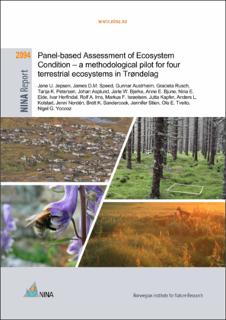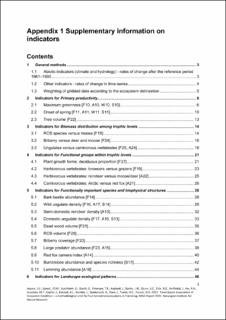| dc.description.abstract | Jepsen, J.U., Speed, J.D.M., Austrheim, G., Rusch, G., Petersen, T.K., Asplund, J., Bjerke, J.W., Bjune, A.E., Eide, N.E., Herfindal, I., Ims, R.A., Israelsen, M.F., Kapfer, J., Kolstad, A.L., Nordén, J., Sandercock, B., Stien, J., Tveito, O.E., Yoccoz, N.G. 2022. Panel-based Assessment of Ecosystem Condition – a methodological pilot for four terrestrial ecosystems in Trøndelag. NINA Report 2094. Norwegian Institute for Nature Research.
The panel-based assessment of ecosystem condition (PAEC) is an evidence-based approach to assess the condition of Norwegian ecosystems. The assessment is carried out by an expert panel with broad expertise in the ecosystems to be assessed and is inspired by approaches used in international assessments such as IPCC and IPBES. The assessment follows an earlier developed protocol. In this report, PAEC is piloted for major terrestrial ecosystems in the county of Trøndelag; forest, alpine, open-lowlands, and wetlands.
For each ecosystem, a list of indicators of change in ecosystem condition in response to anthropogenic drivers is developed. The indicators fall within seven main ecosystem characteristics: primary production, biomass distribution among trophic levels, functional groups within trophic levels, functionally important species, biological diversity, landscape ecological patterns, and abiotic factors. The expected change in indicators in response to anthropogenic drivers are termed phenomena, and their selection is based on published literature, including reference to the confidence of a change being observed in response to anthropogenic drivers and the mechanism leading to a deterioration in ecosystem state. Datasets to quantify each indicator are identified and collated and the quality of each dataset is assessed in terms of its spatial and temporal appropriateness.
In the first assessment step, the validity (VP) of each phenomenon is scored and used to infer confidence in the causal relationship between changes in the indicator and anthropogenic drivers. The next step is an evaluation of the biological and statistical significance of the evidence for the occurrence of each phenomenon, termed evidence (EP) of the phenomenon. The third step is a consolidated assessment of the ecological state based on the associated indicators and phenomena, first for each ecosystem characteristic, and subsequently for the ecosystem as a whole. The assessment is based on the validity, the quality of the evidence, and the data quality for each phenomenon. This provides a qualitative assessment of deviation from the reference condition of “no deviation”, “limited deviation” or “substantial deviation”. The assessments are each supported by narrative accounts. The pilot assessment involved analysis of 24 datasets documenting 41 indicators. Several indicators were included in multiple ecosystems. In total there were 27 indicators used for forest ecosystems, 24 for alpine ecosystems, and 16 in each of wetlands and open lowlands.
In the forest ecosystems, substantial deviation from the reference condition was identified for five of the ecosystem characteristics. The two exceptions were primary productivity where there was a limited deviation from the reference condition, and biological diversity where there was no deviation from the reference condition (but the latter was based on a single indicator and hence an entirely inadequate indicator coverage). The deviations were found primarily in climatic variables, cervids and their forage and predators, and dead wood. Overall, the forest ecosystem was assessed as having a substantial deviation from the reference condition.
In the alpine ecosystems, substantial deviation from the reference condition was identified for the abiotic ecosystem characteristic, largely attributed to indicators associated with temperature, seasonality, and snow. Limited deviation from the reference condition was assessed for functionally important species and primary productivity (both based on a partially adequate indicator coverage) and for biological diversity, functional groups within trophic levels and landscape ecological patterns (but these were based on an inadequate indicator coverage). For the ecosystem characteristic biomass distribution among trophic levels, the quality of evidence was insufficient to conclude regarding the condition of the single indicator involved, and no overall assessment of this ecosystem characteristic could be undertaken. Overall, the alpine ecosystem was assessed as having limited deviation from the reference condition.
For both open lowland and wetland ecosystems, several ecosystem characteristics were not assessed due to a lack of relevant indicator datasets. For this reason, no overall assessment of the ecosystems as a whole could be undertaken. However, for both ecosystems, there was a substantial deviation from the reference condition for abiotic factors (temperature, seasonality, and snow). In open lowlands, there was a substantial deviation in functionally important species (ungulates) and limited deviation in primary productivity and biological diversity. In wetlands, there was a limited deviation from the reference condition in primary productivity, biological diversity, and landscape ecological patterns.
Most challenges encountered during this pilot assessment related to the inadequacy of the datasets for assessing ecosystem condition. Reasons behind this include that ecosystem extents are not adequately mapped, particularly those characterised by small and fragmented patches, and a taxonomic or geographical limitation of datasets and environmental monitoring. The report suggests further development of indicators for operational application. Finally, the report also suggests knowledge needs and prioritisation for further research to support the future implementation of ecosystem assessments in Norway. | en_US |

